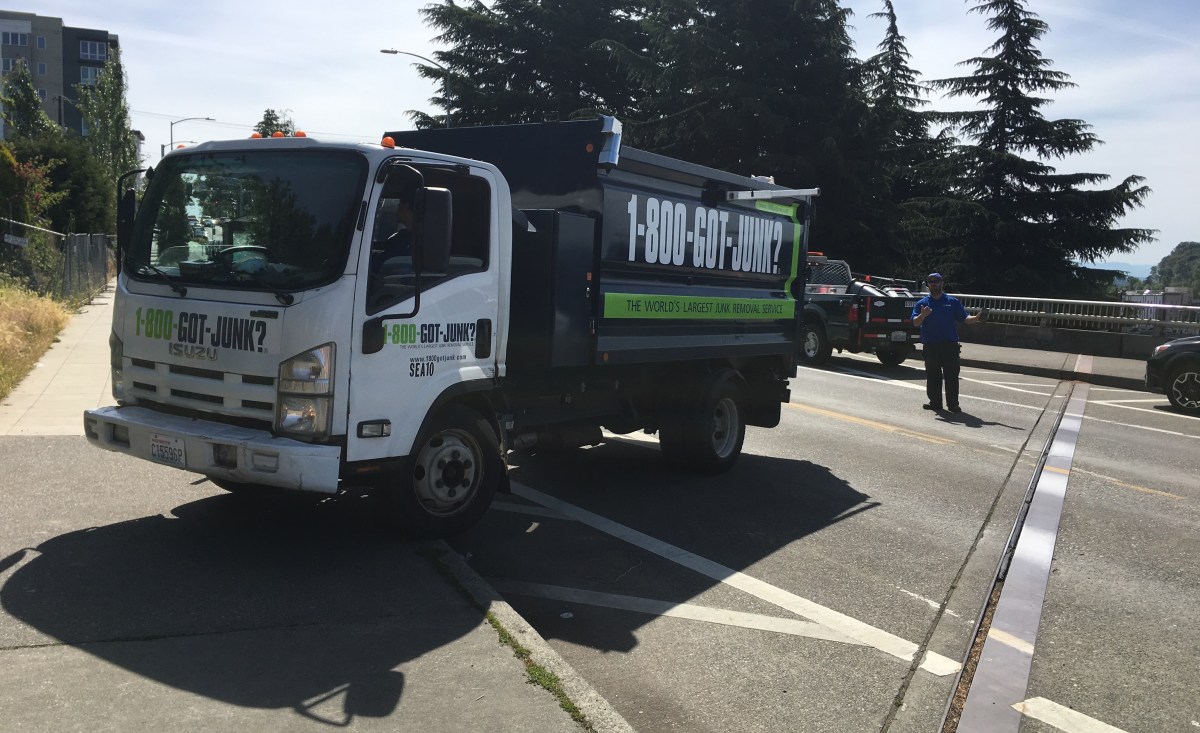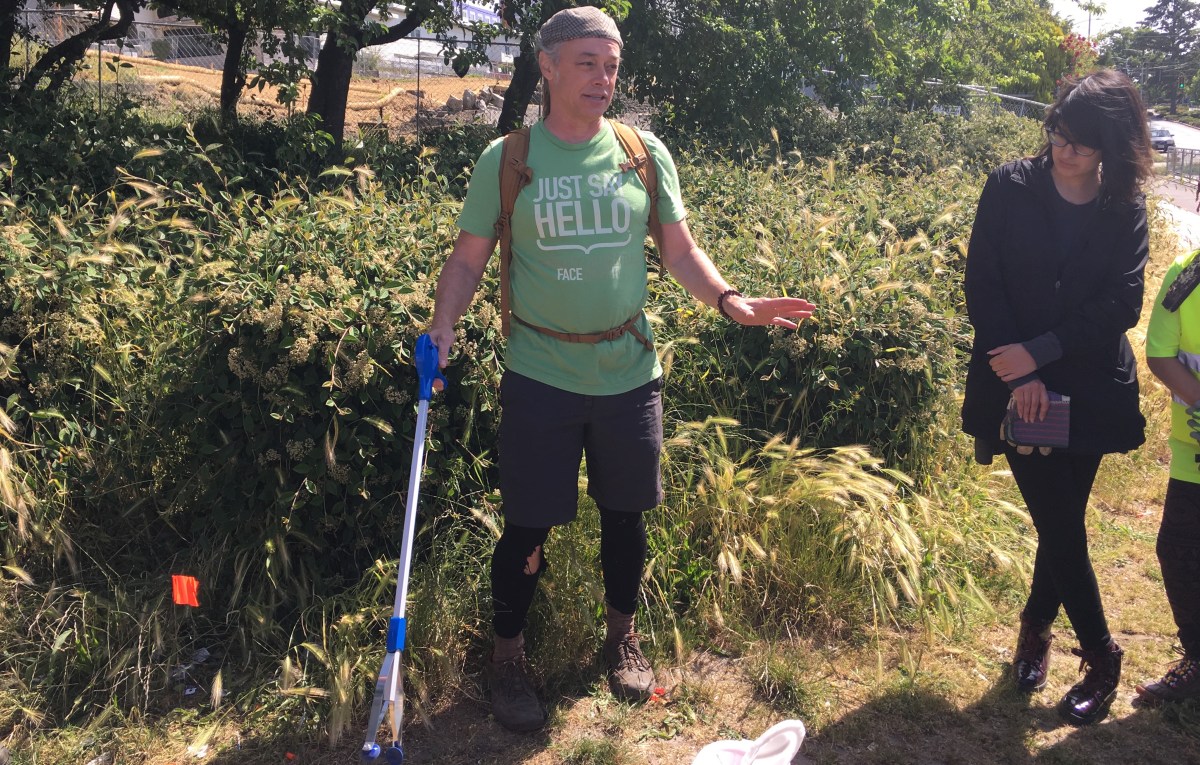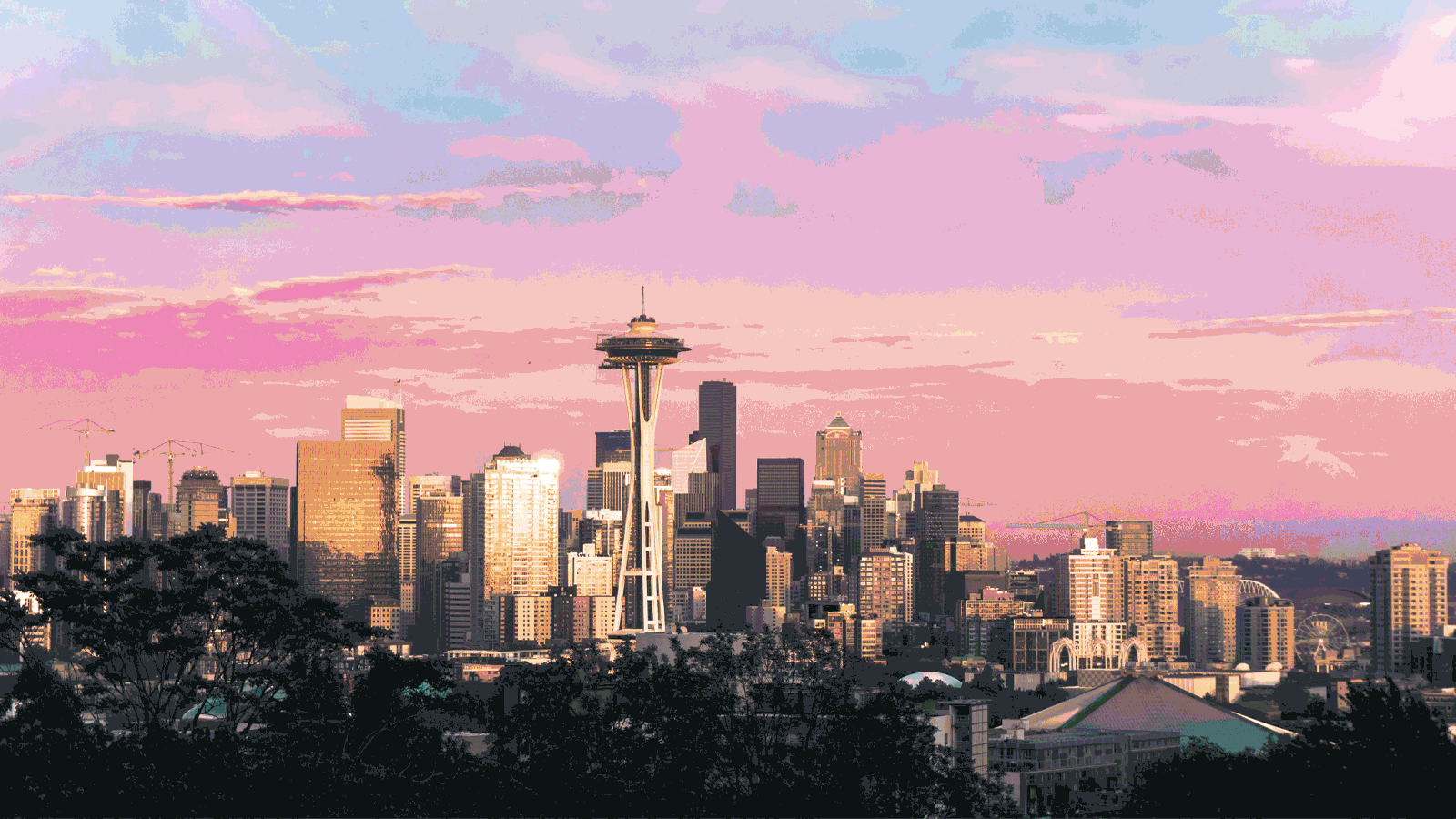The 6-foot-long mauve couch just showed up one night.
So did the washing machine, and the box spring, and the piles of office chairs that littered a homeless encampment on a hillside overlooking downtown Seattle in early June, where a 1-800-Got-Junk truck just pulled away after picking up a load*, piled to the brim.
“I’ve seen televisions, couches, random bags of trash that isn’t ours,” said Jody**, who has been homeless for about two years and was living in a tent near the top of the hillside on the day of my visit, directly below a large apartment complex.
“Things will just appear. People in those apartments there” — she gestured further up the hillside — “dump bags of trash over the fence.” Jody’s friend Robyn, who was living with her partner in a nearby tent at the time, added, “People dump stuff here all the time. I don’t know why. They’re so lazy — you have trash service, why don’t you use it?”
As homeless encampments proliferate across the country, so do the piles of trash that build up in, around, and near them — trash that local waste management companies struggle to collect. The problem is particularly intractable on the West Coast, where rising housing costs have combined with a lack of investment in shelters to create a proliferation of tent cities from Los Angeles to Vancouver.
In Los Angeles, the number of people living outside or in cars rose 16 percent over the past year to more than 27,000. And in Seattle, the one-night count in January found 3,558 people living without shelter, a slight decrease from last year. Unsheltered people are surrounded by a staggering amount of trash: Garbage collectors report picking up five to seven tons every day in Los Angeles; 24 tons at a single encampment in Berkeley; and 8.5 tons along a single stretch of Interstate 84 in Portland, according to Portland Mayor Ted Wheeler.
In Seattle, the city picked up 355 tons of trash at or near 71 encampments in just the first three months of this year. But as in Los Angeles — where L.A. Times columnist Steve Lopez recently reported that local merchants “routinely dump their own trash on the streets or pay homeless people a few bucks to get rid of it for them” — the story in Seattle is more complicated than it seems.
James Shepard, a member of Seattle’s Navigation Team (a joint effort of the city’s human services and police departments responsible for cleaning up and removing encampments), watched as the 1-800-Got-Junk truck pulled away. He said that people come here and to other nearby encampments “in the middle of the night” and unload stuff from their cars and trucks, including furniture and other heavy items that are supposed to go to the local dump. “I don’t see them toting stuff down during the day, but I’ll come up here in the morning and there will be mattresses there,” Shepard said.
The practice doesn’t just make encampments more unsightly. It also makes them more vulnerable to rapid removal by the city, which, under Seattle Mayor Jenny Durkan, increasingly justifies removing encampments without prior notice on the grounds that a camp has so much trash that it constitutes an “obstruction” or a health or environmental hazard.
The result is a vicious cycle: Campsites draw illegal dumping, which adds to the trash that is already piling up because the city doesn’t provide trash pickup at the vast majority of encampments. Once the trash pile gets big enough, it can be used to justify removing not just trash but people, who move on to the next encampment site. Many move deeper into the city’s parks and greenbelts to avoid detection, making them harder to reach. Service providers and advocates say these rapid removals also deepen mistrust between people living in encampments and the city government, which is supposed to be the bridge connecting homeless people with shelter, housing, and services.
Shepard gestured down the hill, where the same truck was just pulling up at another encampment two blocks from City Hall. “We’re going to [remove] both of these encampments soon, I’m sure,” he said. “They’ll go a block away and just come back when we have it spotless. We’re like housekeeping.”

Erica C. Barnett
People living in homeless encampments undoubtedly produce some of the millions of pounds of trash the city hauls away from these encampments every year. But the numbers suggest that much, maybe most, of the trash is brought in by people who see encampments as convenient spots for dumping their unwanted junk. The 355 tons of trash picked up by the Navigation Team amounts to about half a ton of trash for every one of the 731 people living in those encampments. By comparison, in that same period, the utility’s 652,000 residential customers generated a total of 60,934 tons of garbage, or less than a tenth of a ton per person.
The logical conclusion (and the one reached by Seattle Public Utilities, which oversees residential and commercial garbage collection) is that homeless encampments have become dumping grounds.
It’s hard to say exactly who’s responsible for the “extra” garbage, since dumping tends to happen at night or out of sight, but it’s clear from the trash itself that illegal dumpers include homeowners dropping off unwanted furniture, construction workers dumping heavy debris that would cost hundreds of dollars to dispose of legally, and businesses discarding toxic chemicals like paints, solvents, oil, and flame retardants, which can contaminate soil and water and must be taken to a separate hazmat facility.
But illegal dumping isn’t entirely the fault of rogue individual actors. Policies contribute, too — from lax enforcement of anti-dumping laws, to a lack of investment in trash pickup at encampments, to the system of encampment sweeps itself, which requires homeless people to move along even when there’s nowhere better for them to go.
Over the past several months, the Navigation Team has increasingly focused its efforts on removing encampments the city considers “hazards” or “obstructions” — a designation that is based, in part, on whether garbage is piling up.
Ordinarily, the city provides three days’ notice, and at least two outreach visits, before removing an encampment. But once a camp is deemed an obstruction, it’s exempt from these notice and outreach requirements, and can be removed with no notice or outreach at all.
Members of the Navigation Team say they still offer outreach when possible, even when removing people’s tents and belongings without notice. If people happen to be around when the team shows up to clear their encampment, for example, they may be told about available shelter beds and given the opportunity to keep whatever they can carry on their backs or haul away. If they aren’t around, the Navigation Team has the right to remove all their possessions, including tents, sleeping bags, identification, and photos and decide which items are “trash” and which will be stored for up to 70 days before the city throws them away.
“They kick you out of the tent and they take your stuff,” said Jody, the woman living in the hillside encampment. “In theory, you can store some stuff like tents, but it’s been my experience that they didn’t give back half of what we gave them.”
Advocates for homeless people say these sweeps make people much less likely to seek or accept services from the city. The nonprofit REACH used to provide outreach services during encampment removals, approaching residents and letting them know about available shelter and services. However, the group recently stopped participating in most removals because they no longer felt “comfortable” standing by while uniformed police officers rousted campers and told them to move along, according to Program Director Chloe Gale.
Jody, whose tent was surrounded by bottles full of carefully discarded needles, said her experience with the Navigation Team has made her wary of people offering shelter. “It isn’t a matter of having a place to sleep; it’s having a place to live,” she said. “Once you’re on the outside looking in, to rejoin [society] is hard, especially the way that we’re treated. It’s like, why would we want to clamber back into the society that has treated us so poorly?”
There’s an irony in Seattle’s ongoing struggle with encampments — one that’s also present in other large, liberal cities dealing with a surge in unsheltered homelessness along with a related upsurge in unmanaged trash.
Seattle may consider itself a “welcoming city,” the kind of place where “In This House, All Are Welcome” signs supporting immigrants and refugees sprout in front of $2 million houses. But in practice, critics say, some Seattle residents are doing their part to help trash the city’s natural areas and drive homeless people from place to place.
In a recent New York Times piece, columnist Farhad Manjoo called this phenomenon a “refusal on the part of wealthy progressives to live by the values they profess to support at the national level.” It’s easy to say you oppose policies that marginalize the homeless, but harder to consider the ways in which individual actions like dumping a mattress next to an encampment on the side of the road contribute to their marginalization.
Rex Hohlbein, the leader of a Seattle nonprofit called Facing Homelessness, first became aware of the problem of illegal dumping at encampments a few years ago, when he was talking to a group of people who lived in RVs near the ship canal that divides Seattle into north and south. Their biggest problem wasn’t getting hassled by the police or other homeless people, they told Hohlbein — it was people who rolled trash down an embankment into their makeshift trailer park in the middle of the night, which made them a target for encampment cleanup crews.
“I grew up in the era of ‘Don’t be a litterbug,’” Hohlbein said, “and it really bothers me to see garbage in the city. But I don’t attach it to the people who are homeless, because there’s nowhere to put it. And at times when a sofa shows up, it’s like, how did that sofa get there? It didn’t come from the people who are living there.”

Rex Hohlbein. Erica C. Barnett
A spokesperson for the city’s Human Services Department, which oversees the Navigation Team, denied that “opportunistic dumping” is a significant problem. The spokesperson, Will Lemke, said that while this kind of dumping “can be an element in some locations,” much of the trash that’s cleared from encampments comes from people who live there, not people who dump trash there.
But Seattle Public Utilities’ Sabrina Register said dumping, including by contractors, is a real issue they’ve been dealing with for years. “During encampment cleans, larger items including wood (used as shelter), appliances, generators, propane tanks, car parts, and bikes are frequently removed in addition to the trash,” Register said.
City Council Member Lisa Herbold, who fought last year to get the city to address the fact that an encampment in her council district was being used as a waste site for construction debris, said it’s important for the city to “distinguish between trash generated by encampments and illegal dumping.”
Last year, according to the Seattle Times, the city spent $3.6 million cleaning up trash at encampments. “If we address the garbage issue differently, there could be less of a need to remove encampments,” Herbold said. “[And] if the city decided that they still needed to remove an encampment, there could be less garbage that they need to pick up.”
Officially, the city maintains that the most effective approach to trash at encampments is the one the Navigation Team is currently using. The Human Services Department declined my request to observe an encampment removal.
At the same time, other city departments, including the city council, are looking for solutions. Seattle Public Utilities runs a small pilot project to collect garbage from up to 10 encampments at a time. The city auditor’s office, which reviews the Navigation Team periodically, proposed expanding the service last October, noting that the effort saved money when compared to the labor-intensive encampment removals by the Navigation Team.
This year, the city plans to expand the pilot, which picked up about half a million pounds of trash last year, to two additional sites. Register, from Seattle Public Utilities, said the utility is also talking with the Seattle Police Department to identify illegal dumping hot spots, doing “emphasis patrols” to catch would-be dumpers in the act, and looking at ways to discourage opportunistic dumping through environmental design, like better lighting, stronger physical barriers, and trimming bushes. (Register said the city considered placing cameras at encampments but ran into privacy concerns, and a police spokesperson said patrolling at potential dump sites would be impractical.)
“I don’t know what the solution is,” Herbold said, but what the city is doing now isn’t working. “This is the most expensive possible way to clean up trash.”
Facing Homelessness’ Hohlbein, whose group provides tents and other supplies to people living outdoors, recently started organizing volunteer cleanups at camps that are frequent targets for Navigation Team removals. He said his “ultimate goal” in organizing these weekly events, which are already drawing dozens of volunteers, is to make encampments less appealing targets for removal.
“We want to have these [cleanups] weekly around the entire city all the time. We want to partner with the city. We want to clean up the city,” Hohlbein said. “But very specifically, we want to stop the sweeps.”
*Language tweaked to clarify company’s role in encampment cleanup.
**In the interest of privacy, I have omitted the last names of homeless individuals I spoke to for this story.



